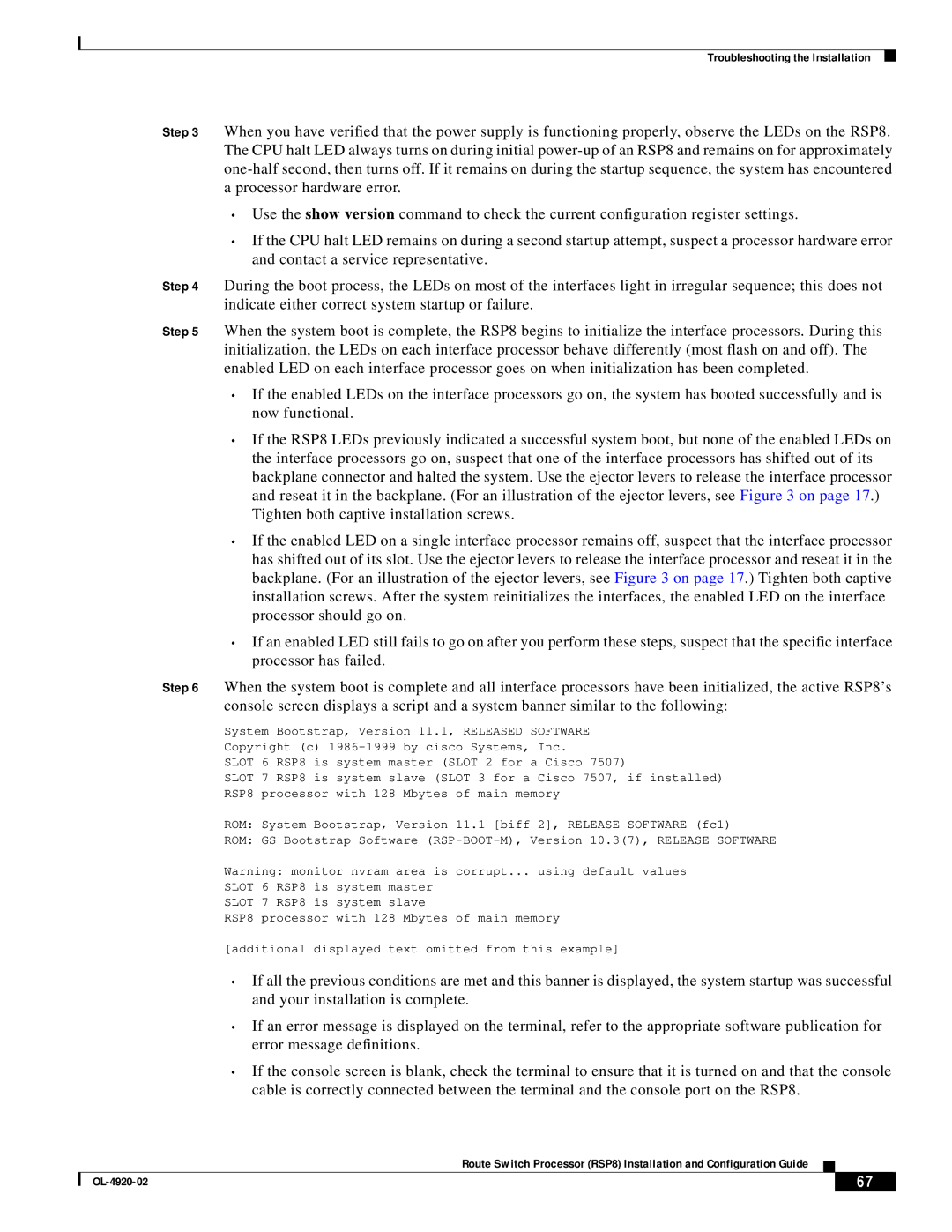
Troubleshooting the Installation
Step 3 When you have verified that the power supply is functioning properly, observe the LEDs on the RSP8. The CPU halt LED always turns on during initial
•Use the show version command to check the current configuration register settings.
•If the CPU halt LED remains on during a second startup attempt, suspect a processor hardware error and contact a service representative.
Step 4 During the boot process, the LEDs on most of the interfaces light in irregular sequence; this does not indicate either correct system startup or failure.
Step 5 When the system boot is complete, the RSP8 begins to initialize the interface processors. During this initialization, the LEDs on each interface processor behave differently (most flash on and off). The enabled LED on each interface processor goes on when initialization has been completed.
•If the enabled LEDs on the interface processors go on, the system has booted successfully and is now functional.
•If the RSP8 LEDs previously indicated a successful system boot, but none of the enabled LEDs on the interface processors go on, suspect that one of the interface processors has shifted out of its backplane connector and halted the system. Use the ejector levers to release the interface processor and reseat it in the backplane. (For an illustration of the ejector levers, see Figure 3 on page 17.) Tighten both captive installation screws.
•If the enabled LED on a single interface processor remains off, suspect that the interface processor has shifted out of its slot. Use the ejector levers to release the interface processor and reseat it in the backplane. (For an illustration of the ejector levers, see Figure 3 on page 17.) Tighten both captive installation screws. After the system reinitializes the interfaces, the enabled LED on the interface processor should go on.
•If an enabled LED still fails to go on after you perform these steps, suspect that the specific interface processor has failed.
Step 6 When the system boot is complete and all interface processors have been initialized, the active RSP8’s console screen displays a script and a system banner similar to the following:
System Bootstrap, Version 11.1, RELEASED SOFTWARE
Copyright (c)
SLOT 6 RSP8 is system master (SLOT 2 for a Cisco 7507)
SLOT 7 RSP8 is system slave (SLOT 3 for a Cisco 7507, if installed)
RSP8 processor with 128 Mbytes of main memory
ROM: System Bootstrap, Version 11.1 [biff 2], RELEASE SOFTWARE (fc1)
ROM: GS Bootstrap Software
Warning: monitor nvram area is corrupt... using default values
SLOT 6 RSP8 is system master
SLOT 7 RSP8 is system slave
RSP8 processor with 128 Mbytes of main memory
[additional displayed text omitted from this example]
•If all the previous conditions are met and this banner is displayed, the system startup was successful and your installation is complete.
•If an error message is displayed on the terminal, refer to the appropriate software publication for error message definitions.
•If the console screen is blank, check the terminal to ensure that it is turned on and that the console cable is correctly connected between the terminal and the console port on the RSP8.
Route Switch Processor (RSP8) Installation and Configuration Guide
| 67 |
| |
|
|
